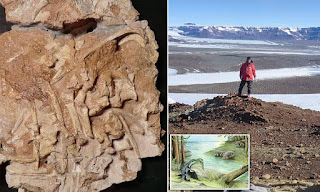There were giants in the earth in those days; Genesis 6:4
"....a forested Antarctica was home to an iguana-size "lizard king."
This ancient reptile was an archosaur — Scientists recently discovered a partial skeleton of the lizard dating to when Antarctica was bursting with plant and animal life.
Though the lizard fossil was incomplete, researchers were able to tell from the fused vertebrae that the animal was an adult reptile, and it likely measured about 4 to 5 feet in length.
They dubbed it Antarctanax shackletoni: The first part of its name comes from the Greek words for "Antarctic king;" the second part is a nod to pioneering British polar explorer Ernest Shackleton, who named the Beardmore Glacier — where many Antarctic fossils, including Antarctanax, have recently been found — following an expedition in 1908.
Antarctica hosted a warm, wet environment where temperatures rarely — if ever — dipped below freezing, the study authors reported.
"We have evidence of widespread forests all over the place, and big rivers moving through those forests," Peecook said. Roaming among the trees and rivers were amphibians, mammal relatives called cynodonts, other mammal-like predators called dicynodonts that had tusks and beaks, and reptiles like Antarctanax, he added."
LiveScience
"....a forested Antarctica was home to an iguana-size "lizard king."
This ancient reptile was an archosaur — Scientists recently discovered a partial skeleton of the lizard dating to when Antarctica was bursting with plant and animal life.
Though the lizard fossil was incomplete, researchers were able to tell from the fused vertebrae that the animal was an adult reptile, and it likely measured about 4 to 5 feet in length.
They dubbed it Antarctanax shackletoni: The first part of its name comes from the Greek words for "Antarctic king;" the second part is a nod to pioneering British polar explorer Ernest Shackleton, who named the Beardmore Glacier — where many Antarctic fossils, including Antarctanax, have recently been found — following an expedition in 1908.
Antarctica hosted a warm, wet environment where temperatures rarely — if ever — dipped below freezing, the study authors reported.
"We have evidence of widespread forests all over the place, and big rivers moving through those forests," Peecook said. Roaming among the trees and rivers were amphibians, mammal relatives called cynodonts, other mammal-like predators called dicynodonts that had tusks and beaks, and reptiles like Antarctanax, he added."
LiveScience

